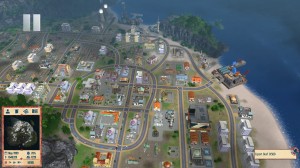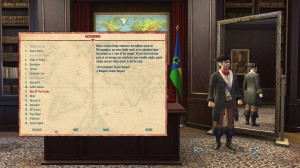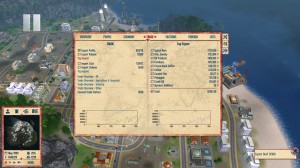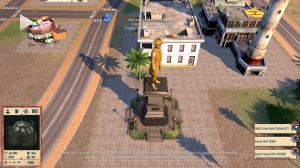The week and a half I’ve played Tropico 4, the Latin American-themed city-builder, has been time well spent. I haven’t started the game’s campaign, but I’ve played enough of the sandbox mode to know I like it – and to know why. Tropico 4 does a number of things right, and while none of them is individually ground-breaking, each of them illustrates a principle of successful design. They are:
1. Difficulty – let me build in peace!
Difficulty in a game can come from two sources. In many (most?) games, from Shogun 2 to Dark Souls, the primary challenge comes from trying to make progress or avoid failure. If the Game Over/You Died screen is a constant companion, then we can say the game is “challenging”. However, even when the player is not at risk of game-ending failure, difficulty can still arise from self-imposed goals. If the game requires skilful play in order to meet those goals, then this is another form of challenge.
When it comes to city-builders, I’ll take the second type of challenge over the first. To me, these titles exemplify gaming as a “narrative of continuous progress”, and as such, I prefer them nice and relaxing. Oh, it’s one thing to have failure lurking in the background. The fear of failure keeps players on their toes – training enough heroes to fight off monsters in Majesty, building apartments and clinics to prevent an uprising in Tropico 4 – but as far as I’m concerned, actual game-overs should be easy to avoid.
And in this regard, Tropico 4 is perfect for me: with the default settings, it takes a lot of doing to lose a sandbox game. Instead, I like to see how effectively I can develop the island of Tropico (thriving economy, good healthcare, clean environment, educated populace, etc) within the constraints of money and time. After finishing five or six sandbox games, most as a benevolent leader and one as a brutal kleptocrat, I think I’m done with this play mode, but it was a lot of fun while it lasted. And there are options for players who want more or less of a challenge, ranging from a weaker/stronger world economy, to a more or less fractious populace, to a de facto god mode. The important thing is, I can tailor the game to meet my preferred play style.
As a contrasting example of what not to do in the city-builder genre, I offer city-builder/RTS/digital ant farm Majesty 2, which was built around an often rock-hard campaign. I would never use the word “relaxing” to describe that game, and while I did enjoy it, I’ll take Tropico 4 any day. (The original Majesty, which I preferred, was closer to Tropico 4 in that it offered a customisable skirmish mode where I could sit back and build, build, build.)
2. A sense of personality
Uninspired video game settings are a subject I’ve bemoaned before. How many generic high fantasy, WW2, or science fiction games do we really need? Luckily, Tropico 4 bursts with character. There’s a sense of place, of course – cheerful Caribbean music accompanies you throughout the game; your island’s key products include pineapples, papayas, sugar and rum; Tropicans speak in Spanish when you click them; and you attract tourists to your island with promises of sun and surf, plus booze for the spring-break crowd or native ruins for the eco-tourists.
But there’s more than that. Almost from the get-go, Tropico 4 is also defined by its – usually black – sense of humour. After clicking past the main menu, the first thing you’ll see is a loading screen, emblazoned with an irreverent (“Politicians are the same all over – they promise to build a bridge even where there is no river.”), bleak (anything from Augusto Pinochet), or, occasionally, off-the-wall (“If surviving assassination attempts were an Olympic sport, I would win the gold medal.”) quote. And that cheerful cynicism permeates the entire game. It’s visible in the choice of traits for El Presidente – the screenshot above shows what the game thinks of “men of the people”. It’s visible in the flavour text for almost every action you take; my favourite is the ethnic village, an utterly bogus tourist trap that you can still show off via a “Geographic TV special”! And it’s visible right to the very end of the game, where one of the objectives on the scoring screen is filling the Presidential bank account. (The game doesn’t stint on ways to go about this. Embezzlement? Artifact-smuggling? Taking kickbacks on construction projects? All of the above?) It’s not the most heartening humour, but it’s distinct.
3. A little bit of real-world resemblance goes a long way
By no stretch of the imagination is Tropico 4 a serious political or economic simulator. But as goofy and abstracted as it is, you can still see the bones of real-life policies embodied within its systems.
My favourite example is the game’s economic model. Almost all businesses on Tropico are owned by the government, and the only tangible goods consumed by Tropicans are food and imported luxuries. (They do, however, consume a wide array of services.) As such, almost everything to come out of a Tropican farm or factory goes straight to the export market, the resulting dollars go straight to government coffers, and the reverse is true – imports deplete the government’s pocket. Making trade surpluses the main source of government income – there are no taxes on Tropico – is quite the abstraction!
However, the net effect is to encourage the player to pursue mercantilism, encouraging exports while minimising imports of consumer goods*. Specifically, it encourages the player to focus on exporting manufactured goods, since these are far, far more profitable than raw materials. In other words, the game effectively leads you down the path of export-led growth pursued by such countries as post-WW2 Germany, Japan, Taiwan, Korea, and of course, China. While this is almost certainly a coincidence**, it’s still a thrill to play the game and realise I’m re-enacting a page out of modern history.
Other aspects of gameplay echo our world. Tropico’s education system isn’t just opiate for the masses – it takes a skilled labour force to operate those factories. (“Skilled”, in this context, meaning “high school educated”. I do wish the game offered more high-end export jobs for university-trained workers.) Building, then subsidising, apartments banishes shanty towns, which are both unsightly and bad for the people’s morale. This even extends to the superficial: one of the game’s silliest white elephants is a rotating golden statue of El Presidente (pictured above)… which happens to be lifted from real life. For folks with an interest in nation-building (or nation-ruining), Tropico 4 can feel like a basket filled with Easter eggs.
Conclusions
If I had to pick just one of the above strengths as a stand-out, it would be #3, seeing elements of real life reflected in the game. Just as there’s a joy in “reaching out to touch history” when playing Europa Universalis 3, so there’s a joy in reaching out to touch issues that could have come from the pages of a newspaper, or an interview with a statesman. But this is not to take away from the game’s other strengths. I laugh at its building descriptions and silly radio conversations, and settling down to develop my island in sandbox mode has been a pleasant, satisfying experience. Tropico 4 won’t hold my interest forever – I’m now ready to move on from the sandpit, either to the campaign or to another title. But even after I shelve the game, I may well read an article on postwar development months or years from now, look back, and smile when I remember my stint as leader of a Caribbean Tiger.
* Except for food. In-game, it’s often more efficient to export cash crops and manufactured goods and just import relatively cheap food.
** Supply-chain management is part and parcel of the city-builder genre, and manufacturing has been a path to virtual riches at least as far back as Colonization.
Discover more from Matchsticks for my Eyes
Subscribe to get the latest posts sent to your email.




I like to think taxes come in the form of rent from the housing provided.
That works too!
Tropicans must love living on my island, because as soon as I can afford it, I always lower apartment rent to $1 (to get them out of the shacks). I don’t actually pass the “free housing” edict, though, because I want to be able to charge higher prices for condos/mansions.
Couldn’t have said it better myself – ever since the original Tropico the export-led mercantilist strategy has been by far my favorite play mode – I always get a euphoric high role playing a benevolent dictator from history transforming a pathetic backwater island into a mighty roaring Caribbean tiger; a Singapore/South Korea of the West Indies. In fact I’ve just finished a game with 7M in the treasury by the year 2000 – onward my overworked/underpaid slaves!
Cheers — glad you liked it!
Wow, that’s impressive! The most I reached was about $1.5M, which was already far too much for me to spend even when I started building every vanity project in sight. How did you manage that?
The general formula I use is to get as many immigrants as your farms/mines/ranches can employ, educate some of them to work in factories, and grab every opportunity to increase production/export prices, whether in-game or preset traits; e.g. the “farmer” background which IMHO is overpowered, “hardworking,” “entrepreneurial” traits, etc. It works even on the hardest economic difficulty setting.
Here are the specifics: spend aggressively in the beginning towards building ranches/farms/mines for exporting beef/cash crops/minerals ASAP. build an immigration office set into “open immigration mode,” alternating with “skilled workers” mode if you get too many unemployed – it’s always better to have a few unemployed than a lot of under-staffed inefficient buildings. Then build a ministry to issue USSR dev’t aid – cheap substandard housing for everyone! – and if you can afford them, either some clinics/churches/pubs or armories/guard stations to keep the ingrates in line. Build marketplaces for food storage/imports. And of course a high school or two for the industrialization phase. Here you can sprinkle in a few hotels and attractions to help balance overhead expenses.
Then build factories – prioritize one industry at a time, most profitable first, and diversify. Hire more teamsters to minimize resource backlogs and supply bottlenecks. Then focus on increasing export prices – build customs house, college, power plant to upgrade mines/factories (after issuing US dev’t aid of course), TV station for “industry ad campaign,” and an airport for the trade missions: If you’re comfortable with exploits you can issue the edict, save before they return, then reload until you get the desired benefit, which in our case is obviously getting all the export premiums.
Build banks set to “urban development” and splurge on happiness/more industries. If you want you can import raw materials and export finished products, but they’re not as profitable as locally-sourced industries due to import costs and the cap on the volume of imported goods (500 units/freighter). But this can be easily overcome by building more docks.
Admittedly the treasury should have been lower since I got lazy by the 1980’s after the local industries have matured and just watched how high it can go until time ran out. Now it’s at 2012 and the treasury is at 12M, with overall happiness hovering around 60% – I get a laugh everytime the capitalist adviser whines about the economy “shrinking” – If you want I can share my save
I need to go back and try tourism yet again. Sadly I never found it profitable. Tourists compete with locals for the venues for instance. And money seems to be fairly lean, compared to, for instance, exporting a bunch of cigars. However, I suspect the playstyle is intended to make the most out of lower educated workforce. Traditionally I only use tourism as a means of dealing with a glut of unemployed souls that come to my hellish backwater under the idea of leading a better life and instead spend their days drawing pictures of El Presidente with sticks on the beach. Nay, half a stick, the rest goes to my logging industry as tax.
However, if tourism were to be done on an island which throws open the doors to immigrants, ample farms and ranches to feed the populace and provide plenty for export to prop up any large expansion projects, then it might make tourism become thriving little industry that can be tucked away on its own little corner of the island.
I haven’t gotten the knack of tourism either yet, but a friend told me that done right, it offers even more bang for the buck than factories. Apparently, tourists/locals going to the same venues is an advantage (because then you can kill two birds with one bar/cabaret/cinema). And yeah, as you noted, Tropicans typically don’t need any schooling to sell martinis or dodgy souvenirs to tourists.
I always tucked it away in its own corner, too. ;) I liked to import food instead of having my own corn farms/ranches, though that exposes you to famine if you don’t have cash when the freighter comes in.
Those guys with sticks on the beach = the workers at the native village?
Maybe I need to try tourism as my next challenge…
Another advantage to tourism is the maids/attendants don’t have to be physically present at their respective facilities for the tourists to pay, and you don’t need an army of teamsters to transport stuff
Oooh, those are great points. My manufacturing sector always ran into logistical bottlenecks!
And by profitable, I should say not as profitable…
I love tourism, that is I love to set the graphics/texture settings to ultra and zoom in real close to the female tourists trotting about or at the beach sites… nah just kidding, I never found it as profitable as factories too.
Dead or Alive: Extreme Beach Tropico?